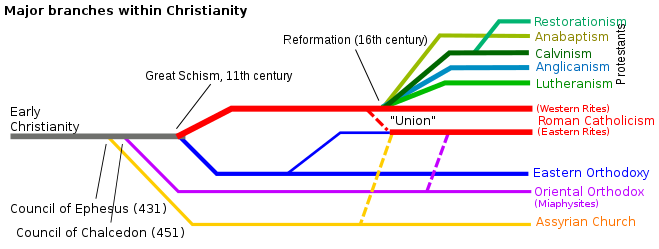Non-Chalcedonian Christianity
This article may need to be rewritten to comply with Wikipedia's quality standards, as it overlaps too much with Oriental Orthodoxy and needs to focus more on the schism and the theological issues (perhaps even to be renamed). (July 2010) |
Non-Chalcedonianism is a religious doctrine of those Christian churches that do not accept the Confession of Chalcedon as defined at the ecumenical of Council of Chalcedon in 451. The doctrine contrasts with Chalcedonian Christianity, which accepts the doctrines of the first seven Ecumenical Councils. Some Christian denominations do not accept the Confession of Chalcedon, for varying reasons, but accept the doctrines of the previous council at the Council of Ephesus in 431.
The most substantial non-Chalcedonian tradition is known as Oriental Orthodoxy. Within this tradition are a number of ancient Christian churches including the Coptic Orthodox Church of Alexandria, the Syriac Orthodox Church (sometimes referred to as "Jacobite"), the Armenian Apostolic Church, the Ethiopian Orthodox Tewahedo Church, the Eritrean Orthodox Tewahedo Church and the Malankara Orthodox Syrian Church.
The Christology of the Church of the East (i.e., Nestorian Christianity) may be called "non-Ephesine" for not accepting the Council of Ephesus, but did finally gather to ratify the Council of Chalcedon at the Synod of Mar Aba I in 544.[citation needed]
Within the Patriarchates of Alexandria and Antioch, the rejection of the Chalcedonian definition became a cause of schism. While the common people of Egypt and Syria mostly objected to the Council, the Byzantine-Greek minority that formed the ruling class mostly accepted the Council. These two parties vied for possession of the ancient sees of Alexandria and Antioch that formed, at the time, the third and fourth most prestigious sees in "Christendom", respectively. Ultimately, neither group absolutely dominated either church. The end result was the existence of two distinct patriarchates of Alexandria and Antioch for almost 1500 years, continuing in the present time. What is now known as the Coptic Orthodox Church of Alexandria is the native Egyptian patriarchal faction of Alexandria that rejected Chalcedon, whereas the Greek Orthodox Church of Alexandria is composed of those who accepted Chalcedon. For Syrians, the Syriac Orthodox Church forms the patriarchal faction of the native Syrian-Semitic population whereas the Greek Orthodox Church of Antioch is composed of those who accepted Chalcedon.
In India and to a lesser degree in Persia, the schism that occurred was between the Oriental Orthodox and the Assyrian Church of the East. Even today in Kerala, there is a continuing presence of both the Assyrian Church of the East and the Syriac Orthodox Church along with an Independent Oriental Orthodox Church called the Malankara Orthodox Syrian Church.

